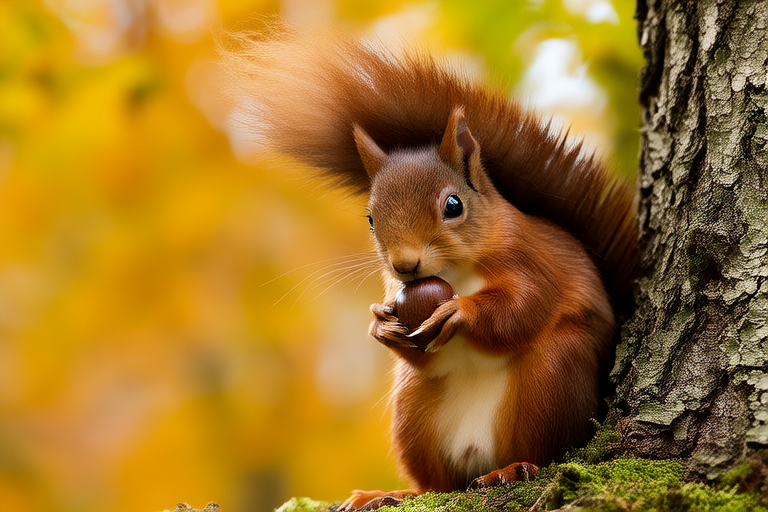Top 7 Fascinating Facts About Your Neighborhood Squirrel
Welcome to a delightful exploration of the world of squirrels that share our neighborhoods. These small, agile creatures are more than just cute critters; they are fascinating animals with complex behaviors and remarkable adaptations. From their impressive acrobatic skills to their strategic food storage, squirrels offer endless intrigue. Let’s dive into seven fascinating facts about your neighborhood squirrel.
- Remarkable Adaptation: The Bushy Tail
Squirrels are often recognized by their large, bushy tails. This tail serves multiple purposes beyond being a striking feature. It acts as a rudder when they leap from tree to tree, ensuring balance and stability during their acrobatic flights. Additionally, it functions as a blanket, providing warmth in colder climates, and as a signaling device to warn others of potential threats. The tail’s size and shape are adapted to the squirrel’s environment, showcasing nature’s ingenious design.
- Diverse Diet: Omnivorous Feast
Contrary to popular belief, squirrels are not strictly herbivores. They are omnivorous, meaning they eat both plant and animal matter. Their diet primarily consists of nuts, seeds, fruits, and fungi, but they also consume insects, bird eggs, and even small vertebrates. This diverse diet allows them to thrive in various environments, including urban settings where food sources might be limited. Their ability to adapt their eating habits ensures survival in changing conditions.
- Strategic Food Storage: The Master Hoarder
Squirrels are renowned for their habit of burying food for later consumption. This behavior, known as caching, is a crucial survival strategy. Each autumn, squirrels collect and store thousands of nuts, seeds, and other edibles in scattered locations across their territory. Interestingly, they often forget where they have hidden some of these caches, which inadvertently aids in forest regeneration. This natural process helps disperse seeds and encourages the growth of new trees, making squirrels vital contributors to their ecosystem.
- Urban Adaptation: Thriving in the City
In cities, squirrels have adapted remarkably well to human presence. They have learned to navigate urban landscapes, utilizing parks, gardens, and even city streets. Their agility and quick reflexes help them avoid predators and obstacles. Urban squirrels have also become adept at finding food in unexpected places, such as bird feeders, trash cans, and even scavenging in gardens. Despite the challenges posed by urbanization, these adaptable creatures have found ways to thrive alongside humans.
- Communication Skills: Vocal and Visual Signals
Squirrels communicate through a variety of vocalizations and body movements. They emit different calls to alert others about dangers or to signal the presence of food. For instance, a sharp bark warns of predators, while a softer chatter might indicate the discovery of a food source. Additionally, they use tail flicks and postures to convey messages. These communication methods are essential for social interactions and survival in their environment. Understanding these signals can provide insight into the life of a squirrel.
- Seasonal Changes: Preparing for Winter
As winter approaches, squirrels prepare by increasing their food caching activities. They spend much of their time gathering and storing food, particularly acorns and other high-energy nuts. This preparation is crucial because it provides sustenance during the cold months when food may be scarce. Their ability to remember the location of many of their caches demonstrates impressive spatial memory. This adaptation ensures their survival through harsh winters, showcasing the intelligence and resourcefulness of these small mammals.
- Family Dynamics: Complex Social Structures
While squirrels are generally solitary creatures, they do form social bonds, especially within family groups. Males and females come together briefly during mating season, but after breeding, they separate again. Mothers raise their young alone, teaching them essential survival skills. Young squirrels stay with their mother until they are old enough to fend for themselves. This period of dependency highlights the nurturing aspect of squirrel life, offering a glimpse into the family dynamics of these common yet mysterious creatures.
In conclusion, squirrels are not only charming visitors to our backyards but also fascinating subjects of study. Their adaptability, resourcefulness, and unique behaviors make them an integral part of our urban ecosystems. By understanding more about these creatures, we can appreciate the complexity of wildlife living among us and perhaps find ways to coexist more harmoniously. Next time you spot a squirrel, take a moment to observe its actions and wonder at the intricate world it inhabits.
